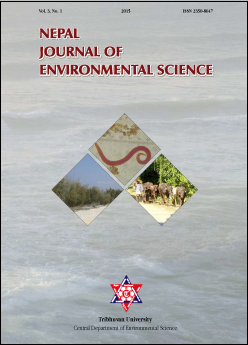Analysis on causes of deforestation and forest degradation of Dang district: using DPSIR framework
DOI:
https://doi.org/10.3126/njes.v3i0.22732Keywords:
Population growth, Forest Fire, Forest EncroachmentAbstract
Forests play a prodigious significance in many aspects. It is home to sundry species that exist on earth. Further, forest plays vital role as sinks of CO2 and has been estimated that standing forests sequester about 20% of global CO2 emission. However, deforestation and forest degradation (D & D) has been continued to be a major global environmental problem. The study was focused on identifying the causes of D & D of Dang district using the Drivers – Pressures – State – Impacts – Responses (DPSIR) framework. A detailed review of relevant and existing literatures about the study area was done and also field observation and survey was carried out during the study in different village development committees (VDCs) of Dang district. Data and information collected were used for preparing the DPSIR model framework making the DPSIR key words table and DPSIR map. The VDCs were identified by comparing the land use land cover map of Dang district of 2000 and 2010. The study reveals that main causes of D & D in Dang District are forest encroachment, population growth, forest fire, urbanization, infrastructure development, illegal harvesting of forest resources, etc. It is causing a serious impact on environment. In order to overcome with the situation, government, with an effort from community people, has started awareness programs and many other activities under forest management programs.
Downloads
Downloads
Published
How to Cite
Issue
Section
License
This license enables reusers to distribute, remix, adapt, and build upon the material in any medium or format for noncommercial purposes only, and only so long as attribution is given to the creator.




